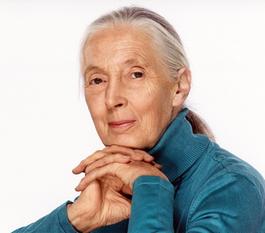 |
|
| Jane Goodall (photo: Andrew Zuckerman) |
|
Jane Goodall, "one of the world's most revered conservationists, who earned scientific stature and global celebrity by chronicling the distinctive behavior of wild chimpanzees in East Africa--primates that made and used tools, ate meat, held rain dances, and engaged in organized warfare," died October 1, the New York Times reported. She was 91.
Her death has sparked tributes worldwide for her lifelong dedication to her work in the field, but the Times also noted that "long before focus groups, message discipline and communications plans became crucial tools in advancing high-profile careers and alerting the world to significant discoveries in and outside of science, Dr. Goodall understood the benefits of being the principal narrator and star of her own story of discovery."
A significant part of that communication was through her work as a writer. She was 29 in 1963 when National Geographic magazine published her 7,500-word, 37-page account of the lives of primates she had observed in the Gombe Stream Chimpanzee Reserve in what is now Tanzania.
"In articles and books, her lucid prose carried vivid descriptions, some lighthearted, of the numerous perils she encountered in the African rainforest," the Times wrote. Her writing gained more attention from three long National Geographic articles during the 1960s and '70s and three well-received books: My Friends, the Wild Chimpanzees (1967), In the Shadow of Man (1971), and Through a Window (1990).
Goodall's mother was an author and novelist who wrote under the name Vanne Morris-Goodall and accompanied her daughter to the Gombe reserve at the start of Jane Goodall's study in 1960. She also became a leading character in her daughter's writing, the Times noted.
Goodall wrote 32 books, 15 of them for children, including Chimpanzees I Love: Saving Their World and Ours (2001) and Rickie and Henri: A True Story (2004, with Alan Marks). Her adult books include Beyond Innocence: An Autobiography in Letters, the Later Years (2001, edited by Dale Peterson), The Ten Trusts: What We Must Do to Care for the Animals We Love (2002, with Marc Bekoff), Harvest for Hope: A Guide to Mindful Eating (2005), Hope for Animals and Their World: How Endangered Species Are Being Rescued from the Brink (2009), and Seeds of Hope: Wisdom and Wonder from the World of Plants (2013, with Gail Hudson).
In her last work, The Book of Hope: A Survival Guide for Trying Times (2021, with Douglas Abrams & Gail Hudson), she wrote of her optimism about the future of humankind.
For a remembrance in the Free Press, Evan Gardner spoke with Richard W. Wrangham, the Ruth Moore Professor of Biological Anthropology, Emeritus, at Harvard, who spent the formative years of his career researching chimpanzees in Tanzania and working as a protégé to Goodall.
Asked about her legacy, Wrangham said: "As a scientist she was, of course, the first person to document the lives of chimpanzees in the wild, and she did so absolutely beautifully. Her 1986 book, The Chimpanzees of Gombe: Patterns of Behavior was a masterpiece of description of the complicated species with many different angles, and it was a very sophisticated description that people still cite, probably more than anything, despite the fact that there are far more people now studying chimps in many different places than during her time. So she set the standard, and she built the foundation for the study of chimpanzees in a really terrific way. That's one aspect of her legacy."
When asked what the one thing is that we should all remember her for, he replied: "I think that the phrase that she would use--she was talking both with respect to chimps and humans--is that every individual matters."

